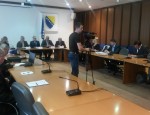 Sarajevo, Bosnia and HerzegovinaMay 20th 2014.
Sarajevo, Bosnia and HerzegovinaMay 20th 2014.
With support from the Danish Embassy, at the beginning of 2014, the Igman Initiative started with the implementation of the project Free Movement of Labor Force between the Countries Signatories of the Dayton Agreement Using the Experiences of the Nordic model of cooperation. Within the project a diverse expert team was formed including the representatives from the four countries, whose task is to assess national legislation as well as bilateral agreements concluded between the four countries and draft recommendations for the improvement of national legislation and conclusion of missing bilateral agreements. Considering that the expert group already concluded the first phase of their research Consultative Session was organized on May 20th 2014 at the Parliamentary Assembly of B&H to which representatives of competent parliamentary bodies and government institutions from the four countries were invited to participate.
At the beginning of the session the opening words were given by Halid Genjac representative of the Parliamentary Assembly of B&H. He highlighted that the priority issue in B&H is unemployment where more than 560 000 people are unemployed making it 40% of population. He also stressed that the movement of labor force within B&H is regulated by bilateral agreements. Of the neighboring countries B&H concluded Bilateral Agreem
Smid, Igman Initiative expert for Croatia.ents with Serbia and Montenegro, while with Croatia the Bilateral Agreement has been initiated but not concluded. He stated that within the framework of the IPA pre-accession funds one of the priority objectives is securing of million new jobs in the Balkans. The addresses were also given by Aleksandar Popov, Co-president of the Igman Initiative for Serbia, Vehid Sehic, Co-president of the Igman Initiative for B&H, Zoran Pusic, Co-president of the Igman Initiative for Croatia, Dragica Misljenovic, Igman Initiative expert from Serbia and Jagoda Milidrag
After these addresses a discussion commenced during which participants had an opportunity to express their suggestions that could contribute to the better formulation of recommendations aimed towards the governments of the four countries. Publication of the expert team will be publicized towards the end of July 2014.
To read full report click Narrative report from Consultative session

